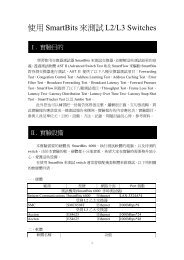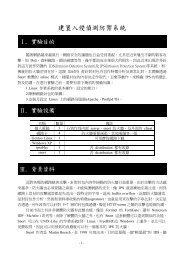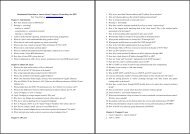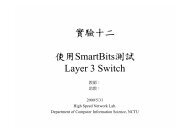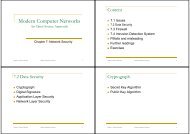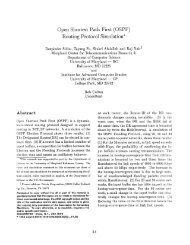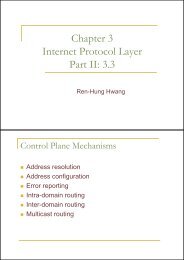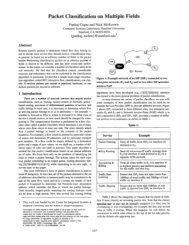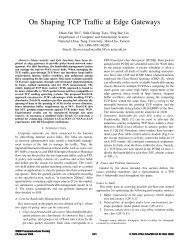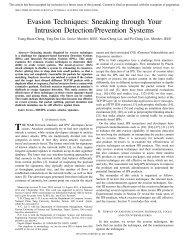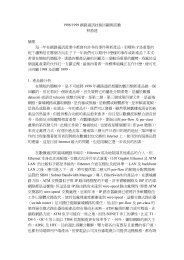Open Source Implementation 2.5: CSMA/CD CSMA/CD is part of the ...
Open Source Implementation 2.5: CSMA/CD CSMA/CD is part of the ...
Open Source Implementation 2.5: CSMA/CD CSMA/CD is part of the ...
Create successful ePaper yourself
Turn your PDF publications into a flip-book with our unique Google optimized e-Paper software.
<strong>Open</strong> <strong>Source</strong> <strong>Implementation</strong> <strong>2.5</strong>: <strong>CSMA</strong>/<strong>CD</strong><strong>CSMA</strong>/<strong>CD</strong> <strong>is</strong> <strong>part</strong> <strong>of</strong> <strong>the</strong> E<strong>the</strong>rnet MAC and most <strong>of</strong> <strong>the</strong> E<strong>the</strong>rnet MAC <strong>is</strong> implemented inhardware. An open source E<strong>the</strong>rnet example <strong>is</strong> available from OPENCORE (www.opencores.org),which cons<strong>is</strong>ts <strong>of</strong> a syn<strong>the</strong>sizable Verilog code. By syn<strong>the</strong>sizable we mean <strong>the</strong> Verilog code <strong>is</strong>complete enough to be compiled, through a series <strong>of</strong> tools, into a circuit. It provides <strong>the</strong>implementation <strong>of</strong> <strong>the</strong> layer-2 protocol according to <strong>the</strong> IEEE specifications for <strong>the</strong> 10 Mbps and100 Mbps E<strong>the</strong>rnet. Note that th<strong>is</strong> open source implementation <strong>is</strong> <strong>the</strong> only hardware example inth<strong>is</strong> text. All o<strong>the</strong>rs are s<strong>of</strong>tware.Hardware Block DiagramE<strong>the</strong>rnetCoreW<strong>is</strong>hbone busHost Interface(Reg<strong>is</strong>ters, WISHBONE interface, DMA support)Tx controlsignalsMIIManagementModuleMACRX dataRX E<strong>the</strong>rnetMACRx controlsignalscontrolsignalsMAC ControlModule(Flow control)TX dataTx controlsignalsTX E<strong>the</strong>rnetMACManagementdataRX dataRx PHYcontrol signalsTX dataTx PHYcontrol signalsE<strong>the</strong>rnet PHYE<strong>the</strong>rnetFigure 2.16 Architecture <strong>of</strong> E<strong>the</strong>rnet MAC core.Figure 2.16 illustrates <strong>the</strong> architecture <strong>of</strong> OPENCORE E<strong>the</strong>rnet Core, which mainly cons<strong>is</strong>ts<strong>of</strong> host interface, transmit (TX) module, receive (RX) module, MAC control module, and MediaIndependent Interface (MII) management module. They are described below.1. The TX and RX modules enable all transmit and receive functionalities. These moduleshandle preamble generation and removal. Both modules incorporate <strong>the</strong> CRC generators forerror detection. In addition, <strong>the</strong> TX module has a random time generation used in <strong>the</strong> back-<strong>of</strong>fprocess, and monitors <strong>the</strong> CarrierSense and Coll<strong>is</strong>ion signals to exerc<strong>is</strong>e <strong>the</strong> mainbody <strong>of</strong> <strong>CSMA</strong>/<strong>CD</strong>.2. The MAC control module provides full duplex flow control, which transfers <strong>the</strong> PAUSE controlframes between <strong>the</strong> communicating stations. Therefore, <strong>the</strong> MAC Control Module has controlframe detection and generation, interfaces to TX and RX MAC, PAUSE timer and Slot timer.3. The MII management module implements <strong>the</strong> standard <strong>of</strong> IEEE 802.3 MII, which provides <strong>the</strong>interconnections between <strong>the</strong> E<strong>the</strong>rnet PHY and MAC layers. Through <strong>the</strong> MII interface, <strong>the</strong>processor can force E<strong>the</strong>rnet PHY to run at 10 Mbps or 100 Mbps, and configure it to performat full or half duplex mode. The MII management module has <strong>the</strong> sub-modules for operationcontroller, shift reg<strong>is</strong>ters, output control module and clock generator.4. The host interface <strong>is</strong> a WISHBONE (WB) bus connecting <strong>the</strong> E<strong>the</strong>rnet MAC to <strong>the</strong> processor1
and external memory. The WB <strong>is</strong> an interconnection specification <strong>of</strong> OPENCORE projects.Only DMA transfers are supported so far for data transferring. The host interface also hasstatus and reg<strong>is</strong>ter modules. The status module records <strong>the</strong> statuses written to <strong>the</strong> relatedbuffer descriptors. The reg<strong>is</strong>ter module <strong>is</strong> used for E<strong>the</strong>rnet MAC operations, and it includesconfiguration reg<strong>is</strong>ters, DMA operation, and transmit and receive status.State Machines: TX and RXIn <strong>the</strong> TX and RX modules, TX and RX state machines control <strong>the</strong>ir behaviors, respectively.Figure 2.17 presents both state machines. We only describe <strong>the</strong> behaviors <strong>of</strong> <strong>the</strong> TX statemachine here, since <strong>the</strong> RX state machine works similarly. The TX state machine starts from <strong>the</strong>Defer state, which waits until <strong>the</strong> carrier <strong>is</strong> absent (i.e., <strong>the</strong> CarrierSense signal <strong>is</strong> false) and<strong>the</strong>n enters <strong>the</strong> IFG state. After <strong>the</strong> Inter-frame Gap (IFG), <strong>the</strong> TX state machine enters <strong>the</strong> Idlestate, waiting for a transm<strong>is</strong>sion request from <strong>the</strong> WB Interface. If <strong>the</strong>re <strong>is</strong> still no carrier present,<strong>the</strong> state machine can go to <strong>the</strong> Preamble state to start a transm<strong>is</strong>sion; o<strong>the</strong>rw<strong>is</strong>e, it goes back to<strong>the</strong> Defer state and waits until <strong>the</strong> carrier <strong>is</strong> absent again. In <strong>the</strong> Preamble state, <strong>the</strong> preamble0x5555555 and Start Frame Delimiter 0xd are sent, and <strong>the</strong> TX state machine goes to <strong>the</strong> Data[0]and Data[1] states to transmit from <strong>the</strong> Least Significant Byte (LSB) nibbles <strong>of</strong> <strong>the</strong> data byte,and <strong>the</strong>n informs <strong>the</strong> W<strong>is</strong>hbone Interface to provide next data byte until <strong>the</strong> end <strong>of</strong> <strong>the</strong> packet.• If a coll<strong>is</strong>ion occurs during transm<strong>is</strong>sion, <strong>the</strong> TX state machine goes to <strong>the</strong> Jam state to sendjam signal, waits for a period <strong>of</strong> back<strong>of</strong>f time in <strong>the</strong> Back<strong>of</strong>f state, and <strong>the</strong>n goes back to <strong>the</strong>Defer state for <strong>the</strong> next transm<strong>is</strong>sion attempt.• When only one byte <strong>is</strong> left to be sent (no coll<strong>is</strong>ion during transm<strong>is</strong>sion),(1) if <strong>the</strong> total frame length <strong>is</strong> greater or equal to <strong>the</strong> minimum frame length, <strong>the</strong>n TX statemachine enters <strong>the</strong> FCS state to calculate <strong>the</strong> 32-bit CRC value from <strong>the</strong> data if CRC <strong>is</strong>enabled, appends <strong>the</strong> value to <strong>the</strong> end <strong>of</strong> <strong>the</strong> frame, and <strong>the</strong>n goes to <strong>the</strong> TxDone state;o<strong>the</strong>rw<strong>is</strong>e <strong>the</strong> TX state machine directly goes to <strong>the</strong> TxDone state.(2) If <strong>the</strong> frame length <strong>is</strong> shorter than <strong>the</strong> minimum frame length and padding <strong>is</strong> enabled, <strong>the</strong>n<strong>the</strong> TX state machine goes to <strong>the</strong> PAD state and <strong>the</strong> data <strong>is</strong> padded with zeros until <strong>the</strong>minimum frame length <strong>is</strong> achieved. The remaining states are <strong>the</strong> same as those in (1).However <strong>the</strong> PAD state <strong>is</strong> skipped when padding <strong>is</strong> d<strong>is</strong>abled.2
Fig. 2.17 The TX (upper) and RX (lower) state machines.Programming <strong>CSMA</strong>/<strong>CD</strong> Signals and Nibble Transm<strong>is</strong>sionFigure 2.18 <strong>is</strong> a segment <strong>of</strong> Verilog code that programs <strong>the</strong> key <strong>CSMA</strong>/<strong>CD</strong> signals and nibbletransm<strong>is</strong>sion. An output signal <strong>is</strong> an arithmetic combination <strong>of</strong> various input signals and updatedonce in every clock cycle. All output signals are updated in parallel, which <strong>is</strong> <strong>the</strong> key differencewith <strong>the</strong> sequentially executed s<strong>of</strong>tware code. The symbols “~”, “&”, “|”, “^” and “=” denote <strong>the</strong>operations <strong>of</strong> “not”, “and”, “or”, “xor” and “assign”, respectively. The conditional expression “exp ?exp : exp”, has exactly <strong>the</strong> same meaning as that in <strong>the</strong> C language.A station observes <strong>the</strong> activity on <strong>the</strong> PHY media in <strong>the</strong> half-duplex mode. Besides <strong>the</strong> carrierdue to <strong>the</strong> transm<strong>is</strong>sion <strong>of</strong> a frame, a coll<strong>is</strong>ion resulting from simultaneous transm<strong>is</strong>sion <strong>of</strong> two ormore stations (denoted by <strong>the</strong> Coll<strong>is</strong>ion variable) <strong>is</strong> also observed. If a coll<strong>is</strong>ion occurs, allstations stop transmitting, set StartJam (entering <strong>the</strong> Jam state) and back <strong>of</strong>f for a random time(StartBackOff <strong>is</strong> set) in <strong>the</strong> Back<strong>of</strong>f state. The state machine may go back to <strong>the</strong> Defer stateif <strong>the</strong> carrier <strong>is</strong> present in <strong>the</strong> Jam state or <strong>the</strong> Back<strong>of</strong>f state.The code in nibble transm<strong>is</strong>sion selects <strong>the</strong> nibble (4 bits) to be transmitted based on whichstate <strong>the</strong> TX machine <strong>is</strong> in. The TX state machine switches between <strong>the</strong> Data[0] and Data[1]states during little-endian transm<strong>is</strong>sion, so MTxD_d, i.e., <strong>the</strong> transmit data nibble, <strong>is</strong> loaded withTxData[3:0] and TxData[7:4] alternatively. In <strong>the</strong> FCS state, <strong>the</strong> CRC value <strong>is</strong> loaded nibbleby nibble, as <strong>the</strong> CRC calculation <strong>is</strong> implemented with <strong>the</strong> Crc shift reg<strong>is</strong>ter. In <strong>the</strong> Jam state, <strong>the</strong>hex value <strong>of</strong> 1001 (i.e., 4'h9) <strong>is</strong> arbitrarily loaded as <strong>the</strong> jam signal, although <strong>the</strong> jam content <strong>is</strong>unspecified in <strong>the</strong> 802.3 standard. In <strong>the</strong> Preamble state, <strong>the</strong> preamble 0x5555555 and StartFrame Delimiter 0xd are loaded in turn.3
<strong>CSMA</strong>/<strong>CD</strong> Signalsassign StartDefer = StateIFG & ~Rule1 & CarrierSense & NibCnt[6:0]
words, one more high-bit in <strong>the</strong> random values <strong>is</strong> likely to be set to 1, which means <strong>the</strong> range <strong>of</strong><strong>the</strong> random values exponentially grows. After <strong>the</strong> random value <strong>is</strong> derived, it will be latched into<strong>the</strong> RandomLatched variable if <strong>the</strong> transm<strong>is</strong>sion channel <strong>is</strong> jammed (judged from <strong>the</strong> StateJamand StateJam_q variables), e.g., due to coll<strong>is</strong>ion. If <strong>the</strong> random value happens to be 0 (i.e.,back<strong>of</strong>f time <strong>is</strong> 0), <strong>the</strong> RandomEq0 variable <strong>is</strong> set and <strong>the</strong> back<strong>of</strong>f procedure will not be started(StartBack<strong>of</strong>f <strong>is</strong> false in <strong>the</strong> last assign statement <strong>of</strong> Figure 2.18).assign Random [0] = x[0];assign Random [1] = (RetryCnt > 1) ? x[1] : 1'b0;assign Random [2] = (RetryCnt > 2) ? x[2] : 1'b0;assign Random [3] = (RetryCnt > 3) ? x[3] : 1'b0;assign Random [4] = (RetryCnt > 4) ? x[4] : 1'b0;assign Random [5] = (RetryCnt > 5) ? x[5] : 1'b0;assign Random [6] = (RetryCnt > 6) ? x[6] : 1'b0;assign Random [7] = (RetryCnt > 7) ? x[7] : 1'b0;assign Random [8] = (RetryCnt > 8) ? x[8] : 1'b0;assign Random [9] = (RetryCnt > 9) ? x[9] : 1'b0;always @ (posedge MTxClk or posedge Reset)beginif(Reset)RandomLatched



